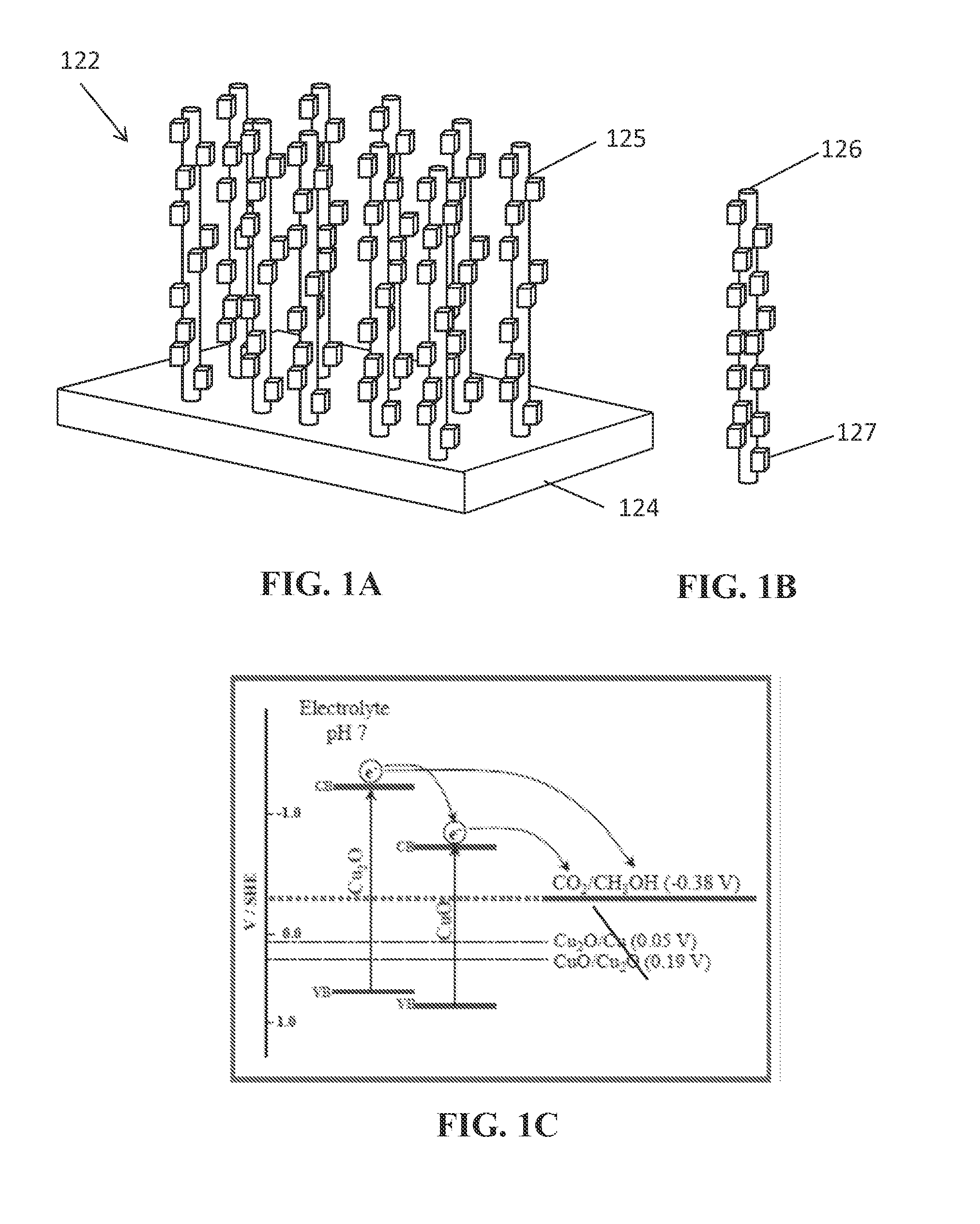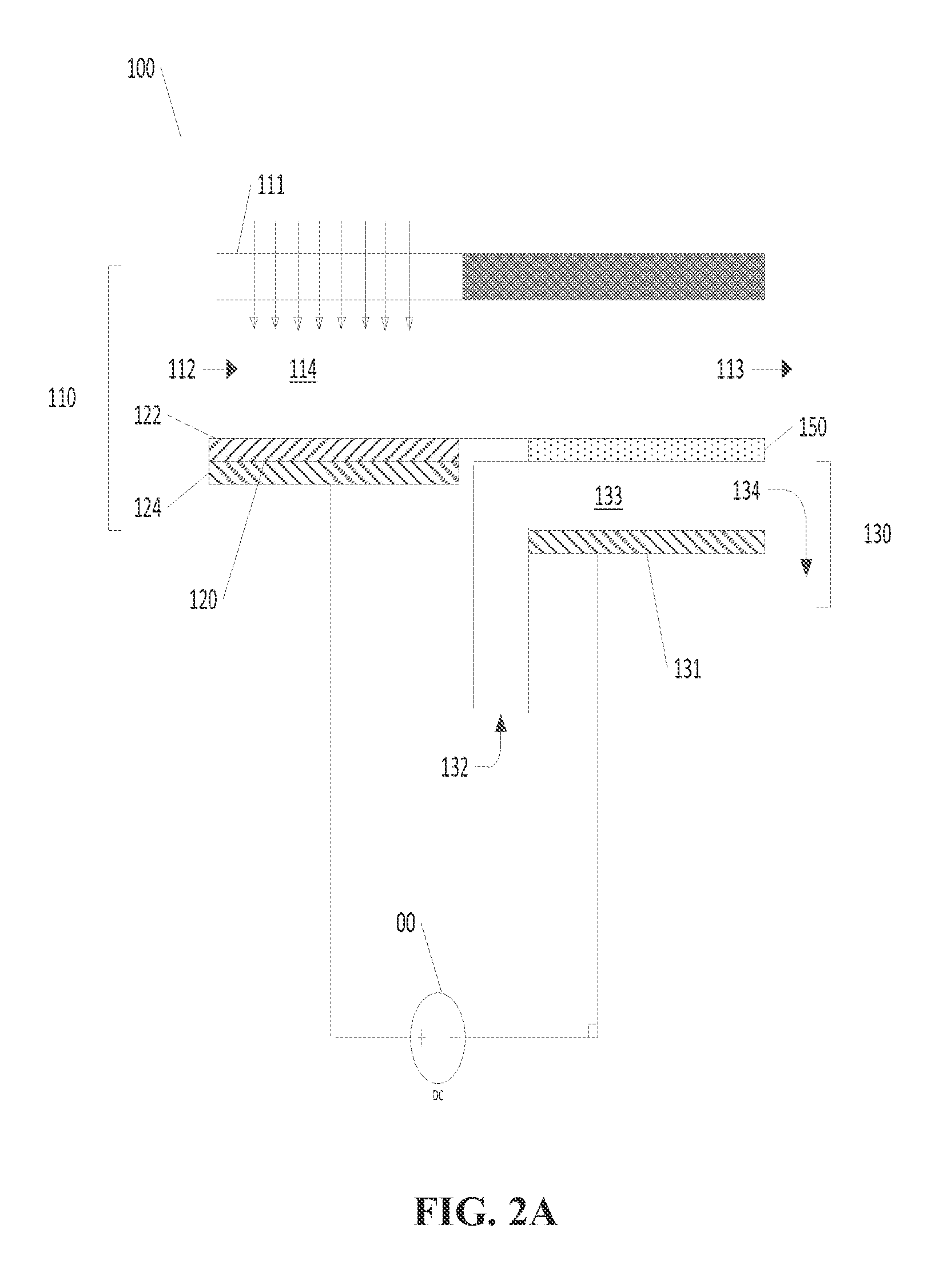Photoelectrochemical devices, methods, and systems with a cupric oxide/cuprous oxide coated electrode
a technology of cupric oxide and photoelectrochemical devices, which is applied in the direction of catalyst activation/preparation, metal/metal-oxide/metal-hydroxide catalysts, energy input, etc., can solve the problems of large carbon footprint of hydrocarbon based products, finite reserves, and presence of fossil fuels, so as to achieve energy efficiency and/or cost efficiency, the effect of reducing the toxicity
- Summary
- Abstract
- Description
- Claims
- Application Information
AI Technical Summary
Benefits of technology
Problems solved by technology
Method used
Image
Examples
example 1
Preparation of a CuO & Cu2O Nanorod Array Photocathode by a Thermal Procedure to Form CuO Array
[0083]In the first step of preparing a nanorod array in accordance with the present disclosure, a CuO nanorod array was formed by a thermal procedure. Specifically, the CuO rods were grown on a copper foil substrate. First, Cu foil was cut to size and was cleaned by immersing in a 1.0M H2SO4 solution, then sonicated in isopropanol, acetone, and deionized water, respectively, and finally, dried under nitrogen gas.
[0084]Next, the CuO nanorods were then grown on the freshly cleaned Cu substrate by a thermal procedure in accordance with the reference: X. Jiang, T. Herricks, and Y. Xia, Nano Letters, 2002, 2, 1333, which is hereby incorporated by reference in its entirety. The copper foil was isothermally heated at 400° C. for 4 hours. A temperature program was used and comprised first heating the sample up to 400° C. (at 25° C. / min). After 4 hours of isothermal heating, the sample was allowed ...
example 2
Preparation of a CuO & Cu2O Nanorod Array Photocathode
[0092]The CuO / Cu2O nanorod arrays were fabricated by a two-step process performed on freshly cleaned copper as described in Example 1. However, this procedure deviates from Example 1. In the first step, freshly cleaned Cu substrates were immersed in the mix solution 8.0 mL of the NaOH solution (10 M), 4.0 mL of a (NH4)2S2O8 solution (1.0 M), and 18.0 mL of water. A few minutes later, a blue color appeared on the copper foil surface, and the solution became increasingly blue. In 15 minutes, a light-blue film covered the copper foil surface. The copper foil was taken out of the solution, rinsed with water, and dried in air. The Cu(OH)2 fibers and scrolls were converted CuO by thermal oxidation in presence of air using a box furnace for 1 h. at 200° C. (at 25° / min.), the temperature was allowed to return naturally to room temperature. Longer soaking times in the solution were also performed (50 min. and 80 min.) and produced the den...
example 3
Converting CO2 to Methanol with the Photocathode
[0094]Photoelectrosynthesis of CH3OH was demonstrated with a TH / ED10 CuO / Cu2O nanorod photoelectrode. A Pt foil and an Ag / AgCl (satd. KCl) were used as the anode and reference electrode respectively.
[0095]The photoelectrode was placed in 100 mL electrolyte solution saturated with CO2, polarized at −0.2 V vs. SHE, and continually irradiated with visible light provided by a AM1.5 solar simulator. The irradiated electrode area was approximately 3 cm2. Representative photocurrent / time and charge / time profiles recorded during the photoelectrolysis are shown in FIGS. 10A and 10B respectively. To analyze the photoelectrogenerated product, liquid samples were periodically withdrawn from the photoelectrochemical cell. A gas chromatograph equipped with a mass spectrometer (GC-MS) was used to detect methanol. Methanol photogeneration was monitored at m / z=31 (CH2OH+) and was found to reach a concentration of approximately 85 μM after 90 min. of ir...
PUM
| Property | Measurement | Unit |
|---|---|---|
| width | aaaaa | aaaaa |
| width | aaaaa | aaaaa |
| length | aaaaa | aaaaa |
Abstract
Description
Claims
Application Information
 Login to View More
Login to View More - R&D
- Intellectual Property
- Life Sciences
- Materials
- Tech Scout
- Unparalleled Data Quality
- Higher Quality Content
- 60% Fewer Hallucinations
Browse by: Latest US Patents, China's latest patents, Technical Efficacy Thesaurus, Application Domain, Technology Topic, Popular Technical Reports.
© 2025 PatSnap. All rights reserved.Legal|Privacy policy|Modern Slavery Act Transparency Statement|Sitemap|About US| Contact US: help@patsnap.com



